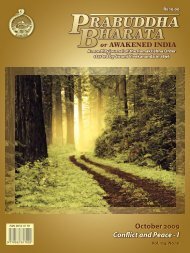P
PB Cover July 2011.indd - Advaita Ashrama
PB Cover July 2011.indd - Advaita Ashrama
- No tags were found...
Create successful ePaper yourself
Turn your PDF publications into a flip-book with our unique Google optimized e-Paper software.
Natha Pantha: Order of the Primordial Shiva 33<br />
PB July 2011<br />
constant and vigilant practice, keeping aside<br />
laziness and the pedagogy of yogic discipline.13<br />
To quote him: ‘Success cannot be attained by<br />
adopting a particular dress. It cannot be gained<br />
by telling tales. Practice alone is the means to<br />
success. This is true, there is no doubt’ (1.68).<br />
For awakening Parameshvari, ‘the Great<br />
Goddess’—also called Bhujangi, ‘a she-serpent’,<br />
Shakti, ‘power’, Ishvari, ‘of the nature of God’,<br />
Kundali, ‘of a bent shape’, or Arundhati, a Vedic<br />
goddess—he suggested yogis to observe brahmacharya,<br />
continence, and always eat sparingly<br />
while following the procedure of śakti-cālana,<br />
flow of energy (3.97–123).14<br />
Several sites, temples, tapasthalīs—places for<br />
ascetic practices—hermitages, monasteries, and<br />
hillocks commemorate Gorakha natha’s name.<br />
For example, Gorakhpur in Uttar Pradesh;<br />
Gorakhamari, or Gorakhamandi, in Kathiawar,<br />
Gujarat; Gorakha temple at Dhinodhar<br />
hill, near Bhuj, Gujarat; Gorakhadanda near<br />
Mangalore, Karnataka; Gorakha-tilla, also<br />
called Tilla Jogian, a hillock in west Punjab,<br />
Pakistan; Gorakha Dibbi in the precincts of<br />
Jwalaji shrine, Himachal Pradesh; Gorakhatari<br />
in Peshawar, Pakistan; and many centres<br />
of worship in Nepal, among which are Bogamati,<br />
Mrigasthali, Sawari Kot, Pidadhan, Bhat<br />
Gaon, and Caughara. The valiant Gurkha community<br />
of Nepal proudly derive their spiritual<br />
lineage from Guru Gorakhanatha. Of the five<br />
main peaks of mount Girnar, the highest (3,666<br />
ft) is named after Gorakhanatha. The other four<br />
peaks—Ambaji, Oghad, Dattatreya (Datta),<br />
and Kalika—are associated with Shaiva or<br />
Shiva-Shakti schools. Some Natha teachers are<br />
said to have been endowed with divine powers<br />
by Dattatreya—called the Adi Guru, primal<br />
spiritual guide—or by mother goddesses, who<br />
are the matrix of the universe. It is believed that<br />
the preceptors of the Natha sect reveal their cosmic<br />
presence in Girnar during Lili Parikrama,<br />
the five-day annual circumambulatory fair held<br />
from the 11th to the 15th of the bright half of<br />
Kartika (October-November).15<br />
Among the major works attributed to<br />
Gorakhanatha are Siddha-siddhāntapadyati,<br />
‘Method and Principles of Adepts’, and<br />
Goraksha-shataka, ‘Hundred Verses of Gorakha’.<br />
Several other texts known after him in Sanskrit,<br />
Hindi, and Punjabi are: Gorakha-gita, ‘Gospel<br />
of Gorakha’, Goraksha Samhita, ‘Collection of<br />
Gorakha’, Jnanamrita, ‘Nectar of Knowledge’,<br />
Yoga-martanda, ‘Sun of Yoga’, Yoga-bija, ‘Seed<br />
of Yoga’, Gorakhabani, ‘The Word of Gorakha’,<br />
and Gorakha-bodha, ‘Realization of Gorakha’.<br />
Gorakṣāsana, the yogic posture which is a panacea<br />
for all diseases,16 is named after him. So are<br />
medicinal herbs like gorakha-mundi (Sphaeranthus<br />
indicus) and gorakha-pana (Heliotropium<br />
strigosum), which he discovered for<br />
healing wounds, eye disorders, and piles; or the<br />
gorakha-cinca tree (Baobab, Amli, Imali, Tamarindus<br />
indica), under whose shade he used to<br />
meditate and teach.<br />
(To be concluded)<br />
Notes and References<br />
1. Swami Pratyagatmananda, ‘Philosophy of the<br />
Tantras’, in Studies on the Tantras (Kolkata:<br />
Ramakrishna Mission Institute of Culture,<br />
2002), 21; S C Banerji, A Brief History of Tantra<br />
Literature (Calcutta: Naya Prokash, 1988), 26.<br />
On the basis of old and middle Bengali literature<br />
Sukumar Sen argues that the Baul cult of<br />
Bengal is ‘a transformed form of the Nātha<br />
Cult’. He affirms that the Bauls have adopted the<br />
yogic discipline of the Nathas as also their mystical<br />
poetry and way of ‘talking in riddles’—see<br />
Sukumar Sen, ‘The Nātha Cult’, in The Cultural<br />
Heritage of India, 4: The Religions, ed. Haridas<br />
Bhattacharya (Calcutta: Ramakrishna Mission<br />
Institute of Culture, 1957), 280.<br />
(Continued on page 501)<br />
493
















